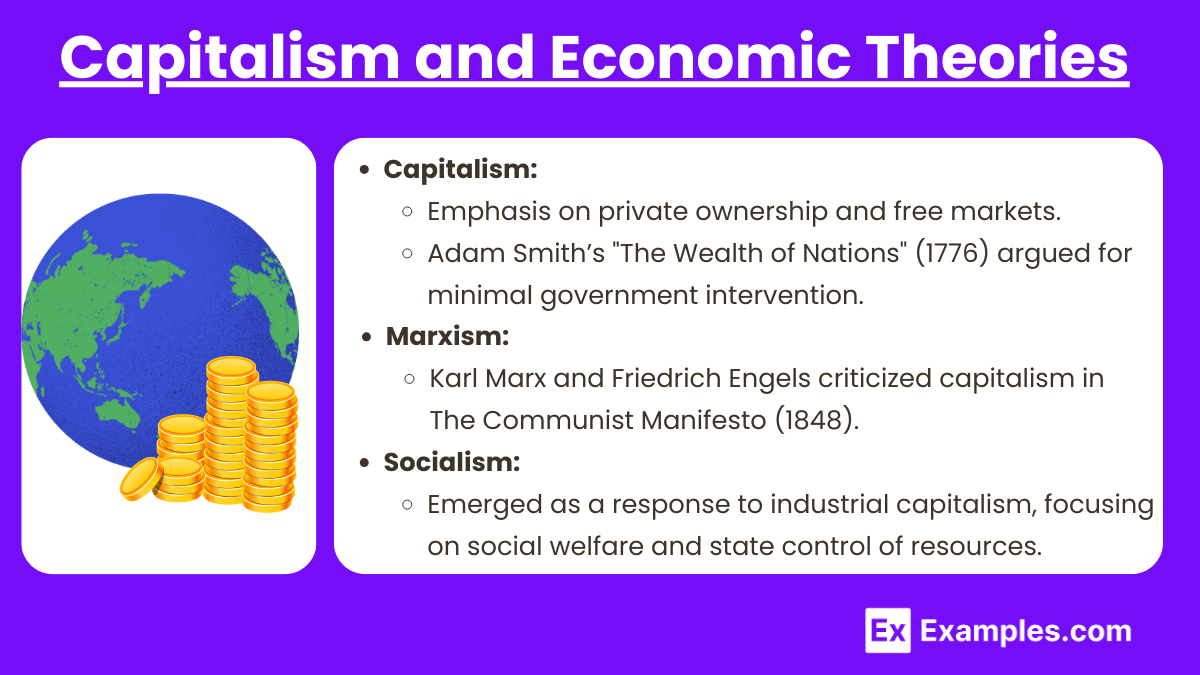Economic change in the modern world has profoundly shaped societies, driven by the Industrial Revolution, globalization, and technological advancements. These transformations have influenced labor systems, trade networks, and financial institutions. Understanding the dynamics of economic change is crucial for analyzing historical developments, including imperialism, environmental impacts, and social movements, all of which play significant roles in shaping our contemporary world.
Learning Objective
In studying “Economic Change” for AP World History: Modern, you should learn to identify major economic transformations, analyze their impacts on societies and global trade, and evaluate the effects of capitalism and industrialization. It’s also important to explore how economic changes influenced social structures and cultural exchanges, providing a comprehensive understanding of their role in shaping historical events and trends.
1.The Industrial Revolution

- Definition: A period marked by the transition from agrarian economies to industrialized ones, beginning in Britain in the late 18th century.
- Key Innovations:
- Textile Industry: Inventions like the spinning jenny and power loom revolutionized production.
- Steam Engine: James Watt’s improvements facilitated faster transportation and manufacturing.
- Iron and Steel Production: The Bessemer process enabled mass production of steel, essential for construction and machinery.
- Effects:
- Economic Growth: Increased productivity and the rise of global trade.
- Social Reform: Labor laws and movements for workers’ rights.Environmental Impact: Pollution and exploitation of natural resources.
2. Capitalism and Economic Theories

- Capitalism:
- Emphasis on private ownership and free markets.
- Adam Smith’s “The Wealth of Nations” (1776) argued for minimal government intervention.
- Marxism:
- Karl Marx and Friedrich Engels criticized capitalism in “The Communist Manifesto” (1848).
- Socialism:
- Emerged as a response to industrial capitalism, focusing on social welfare and state control of resources.
3. Global Trade and Economy

- Globalization:
- Increased interconnectedness through trade networks.
- Rise of multinational corporations and global supply chains.
- Key Commodities:
- Cotton, sugar, and tea became vital trade goods, heavily influencing economies.
- The transatlantic slave trade was integral to economic development in the Americas.
- Imperialism:
- European powers expanded their empires, seeking raw materials and markets.
- Economic exploitation of colonies led to wealth for European nations at the expense of colonized societies.
4. Financial Institutions and Economic Policies

Financial Institutions
- Banking Systems: Development of modern banks facilitated loans and investments, crucial for industrial growth.
- Stock Exchanges: Enabled businesses to raise capital by issuing shares, allowing for expansion and innovation.
Economic Policies
- Mercantilism: Early economic policy focused on maximizing exports and minimizing imports; gradually transitioned to free trade.
- Tariffs and Trade Agreements: Governments implemented tariffs to protect local industries; international agreements shaped trade relations.
5. Responses to Economic Change

Labor Movements:
- Formation of unions advocating for workers’ rights.
- Strikes and protests for better wages and working conditions.
Reform Movements:
- Government intervention through labor laws and social reforms.
- Emergence of socialist and communist parties promoting economic equality.
Social Changes:
- Shifts in class structure, with a growing middle class.
- Increased awareness of social issues related to industrialization.
Political Responses:
- Rise of political parties focused on labor and social issues.
- Policies aimed at regulating industry and protecting workers.
Examples
Example 1: Rise of E-commerce
The growth of online shopping transformed retail, allowing consumers to purchase goods globally with convenience and speed.
Example 2: Green Energy Transition
Increased investment in renewable energy sources, like solar and wind, reflects a shift towards sustainable economic practices and job creation.
Example 3: Gig Economy Growth
The rise of freelance and contract work through platforms like Uber and Upwork reshaped traditional employment structures and income sources.
Example 4: Microfinance Expansion
Providing small loans to entrepreneurs in developing countries empowered individuals, fostering economic development and reducing poverty through local businesses.
Example 5: Blockchain Technology
The emergence of blockchain revolutionized finance, enabling secure transactions and new economic models through cryptocurrencies and decentralized finance systems.
MCQs
Question 1
What was a significant impact of the Industrial Revolution on labor?
A) Decreased productivity
B) Increased reliance on agricultural work
C) Shift to factory-based jobs
D) Elimination of child labor
Answer: C) Shift to factory-based jobs
Explanation: The Industrial Revolution led to a massive shift from agrarian labor to factory-based jobs, as people moved to urban areas in search of employment in industrial settings. This change significantly altered the workforce structure, creating new opportunities but also raising issues like long hours and poor working conditions.
Question 2
Which of the following best describes the transition from mercantilism to capitalism?
A) Increased government control over economies
B) Emphasis on free markets and competition
C) Decrease in global trade
D) Focus on colonial expansion for resources
Answer: B) Emphasis on free markets and competition
Explanation: The transition from mercantilism to capitalism involved moving away from government control and trade regulations towards a system that emphasized free markets, competition, and private ownership. This shift fostered innovation and economic growth as businesses sought to maximize profits in an open market.
Question 3
What was a major consequence of the Great Depression?
A) Economic prosperity worldwide
B) Increased international trade
C) Rise in unemployment and poverty
D) Strengthening of laissez-faire policies
Answer: C) Rise in unemployment and poverty
Explanation: The Great Depression had devastating effects on economies globally, resulting in widespread unemployment and poverty. As businesses failed and banks collapsed, many people lost their jobs and savings, leading governments to adopt interventionist policies to stimulate economic recovery and provide relief to the affected populations.


